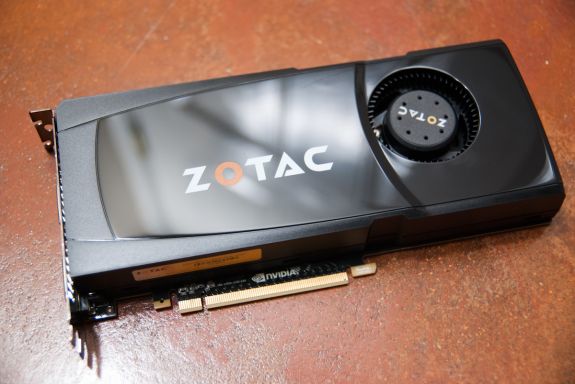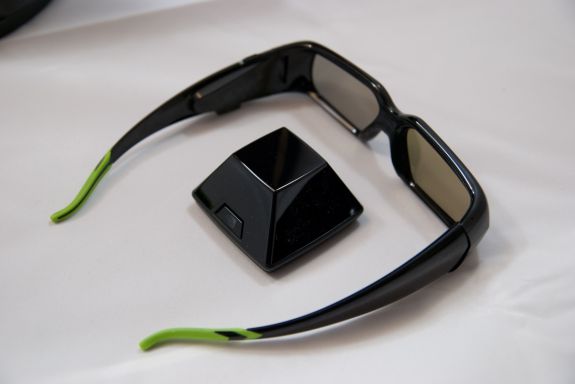ASUS VG236H 23-inch 3D Display Review: 120Hz is the Future
by Brian Klug on August 7, 2010 2:48 AM EST3D Vision on the VG236H
So let’s talk about 3D for a bit before going into the deep bits of the display’s performance. We’ve already covered NVIDIA’s 3D Vision here, but this review would just be incomplete without discussing how much I’ve changed my mind about 3D after playing with the VG236H.
First off, the NVIDIA 3D Vision kit itself is unchanged, though the packaging is a bit more compact. Inside is a soft cloth bag for the classes, two different nasal guides for comfort, two different length USB cables, the IR base station pyramid, shutter glasses, and demo and driver CDs. It feels like a high end product, with the base station pyramid and glasses sitting in foam cutouts, and the requisite accessories in a compartment above.
Additionally, you’ll need a 3D Vision compatible GPU, and can only drive 120Hz refresh rates over DVI-D, not HDMI. Because you’re rendering twice the frames (one for each eye), you’ll take a framerate hit for enabling 3D, so that GPU best be powerful. Zotac graciously supplied their ZOTAC GeForce GTX 470 for testing, which worked perfectly in my testbench.
I noted before that I’ve been skeptical about mainstream 3D gaming for some time now. I’ve seen my fair share of 3D content - though not as much as most of the other AnandTech writers that experienced it at CES on myriad displays - but have an above average grasp for the tech thanks to my optical sciences background.
That out of the way, most of the shutter or polarization based methods I’ve seen up until now suffered from being flickery. Refresh rate just wasn’t high enough, and the result was that I could detect individual frames when moving my head or really looking for it. In theaters, I tried the circularly polarized passive RealD system, and another IMAX 3D system using linear polarization. I had also tried a number of active LCD shutter systems on LCD TVs. While impressive, all of them had noticeable flicker.
The VG236H is the first 3D implementation I’ve played with that doesn’t have noticeable flicker. It just doesn’t. I was immediately impressed with the NVIDIA 3D Vision setup.
NVIDIA thankfully has a pretty comprehensive list of 3D Vision games and how good they perform with the whole system. At the top of the scale is 3D Vision Ready, meaning the game has basically been developed from the start to be viewed in 3D or 2D. Down the list is excellent, good, fair, poor, and not recommended. I first tried a number of ‘good’ titles, and found that while the 3D experience indeed worked, but often small things got in the way.













121 Comments
View All Comments
Seikent - Monday, August 9, 2010 - link
No, when the monitor is using 60hz, it is like a normal lcd monitor (tested with other 120hz monitor).sleepeeg3 - Saturday, August 7, 2010 - link
TN+Film is 256k colors. Have fun stumbling around in a pitch black room at 120fps, because the display can not render enough gray levels to show any detail.The sooner people stop settling for this inferior technology, the sooner prices will drop on IPS panels.
Quit buying TN+Film!
dingetje - Sunday, August 8, 2010 - link
yep, we need more picky buyers!!....and well, that's not gonna happen...that's why we now have 1920X1080 panels instead of 16:10 displays :(DarkUltra - Sunday, August 8, 2010 - link
Don't sell us short. Keep enlightening people, and before you know it there will be a market for excellence just as there is a market for high quality motherboards. You know, things like 24 phase power, 2oz Copper layer, Solid Capacitors, Ferrite core chokes, dual bios etc.Heatlesssun - Sunday, August 8, 2010 - link
Would be nice to have a 120Hz IPS monitor to buy.seapeople - Sunday, August 8, 2010 - link
Have fun paying 2x as much for an IPS monitor to appease your color sense. People have obviously chosen price over quality here, it's not necessarily ignorance. There are plenty of $600+ IPS panels for you to buy, and I'm sure in a while they'll bring out an $800 120h IPS panel for you to buy six of in your Eyefinity set up. But for the rest of us there's something called money that constitutes an important part of purchase decisions.I always get the feeling that the anti TN-monitor freaks are somewhat similar to the Apple fanboi's... "But my $3000 Macbook Pro is just so much nicer than that similar functionality $1500 Windows Laptop! Everything looks better! The quality! The smoothness! I don't understand all you Windows lemmings who settle for such crap!"
AnnonymousCoward - Monday, August 9, 2010 - link
$400 more for my window into the world, which I look at every day, for the next 5 years, is well worth it. You can drive your $12000 car, and I'll drive a $11600 and enjoy a much better screen. And no, I don't like Apple.Patrick Wolf - Monday, August 9, 2010 - link
Your Apple fanboi comparison is laughable. They aren't remotely similar. You can put a good IPS next to a "good" TN and see an immediate and obvious difference. Some people are willing to pay for that difference, some aren't. IPS people choose quality. Peried.Zap - Monday, August 9, 2010 - link
Sure, put them next to each other and you can probably see a difference, but can the average Joe see a difference if they weren't next to each other? I have a number of LCD monitors in my household, including TN (Acer Ferrari), MVA (Soyo Topaz) and IPS (Dell 2005FPW). My primary use is gaming and web browsing, and I don't notice much difference past the size, which while engrossed in games I don't notice after a while but I do notice the extra pixels of the 24" for stuff like web browsing. Beyond that, they all look fine to me. Of course I'm not actively looking for flaws, but I'd be willing to wager that neither are most computer users.Now, I do notice some difference between really old LCD monitors and newer ones. I don't know if the picture degrades over time or if panel tech has improved, but if you want to do those side-by-side comparisons with TN panels, try a new (and decent quality) TN based monitor next to some 8 year old LCD of any kind, and see which one looks better (outside of viewing angle). I mentioned "decent quality" because you can get two different monitor models/brands using the exact same panel and one may have a better looking picture than the other due to factors beyond which panel they use.
Pastuch - Monday, August 9, 2010 - link
Fantastic post ZAP. I couldn't agree more. TN has made huge strides in picture quality in the last couple years and the new E-IPS displays don't compare to S-IPS AT ALL. Not even close.Asus VW246 vs Dell U2311 vs NEC EA231Wm vs Dell 2005fpw vs HP2475
In the last year I have purchased an Asus VW246h (TN), NEC EA231WMi (E-IPS) and a Dell U2311 (E-IPS). I also own a Dell 2005FPW (S-IPS) and I use an HP 2475 (S-IPS) at work.
I have 20/15 vision in both eyes and I'm a picture quality snob. I wish I didn't love video games because finding a monitor that is good for everything is impossible.
Note: I have not calibrated any of the displays tested here. I am ordering an X-Rite I1 Display LT soon.
Picture Quality comparisons:
Asus TN vs Dell and NEC IPS:
I prefer the blacks and contrast on the Asus VW246H (TN) compared to the Dell and NEC E-IPS displays. The Asus has a more life-like 3d image and I was blown away by it immediately. It's easily the best picture quality I have seen on a TN monitor (Yes it still sucks compared to an S-IPS). The E-IPS have good color accuracy and viewing angles. The Anti-glare coating on the NEC was HORRIBLE, the Dell has a much less distracting AG coating. I found very minimal back light bleed on any of the new monitors I have purchased, this was a welcomed surprise. The E-IPS definitely do have color uniformity issues from left to right. The TN does not have that problem. The TN is also more responsive in FPS games and has less ghosting. The difference between the Dell and the Asus was small though (Re: Ghosting). I have yet to try a 120hz monitor so I can't give an opinion there. I honestly think E-IPS is a disappointment and a high quality TN panel can match and/or beat it's performance despite the inherent limitations. It seems like all the new monitors coming out in 2010 have made big improvements in reducing input lag which I think is terrific. Ghosting I can live with but Input lag is just awful. I will be returning the Dell U2311 (Already returned the NEC) even though it has a great stand and excellent user interface because I like the picture quality of the less expensive Asus TN more. If you're hell bent on getting an E-IPS display I would definitely buy the Dell over the NEC. The new 27 inch Asus VE276Q looks really interesting. I would probably buy that or the Dell U2410 depending on your priorities. I'm assuming the Asus VE276Q has a low input lag based on the fact that most Asus monitors have VERY low input lag.
Dell S-IPS vs. HP 2475 vs. E-IPS and Modern TNs.
My much older Dell 2005FPW has good blacks, great contrast and solid color accuracy but it's definitely showing it's age when compared to the modern TNs. When I bought the 2005FPW it absolutely destroyed any TN available at the time but that performance advantage is gone. The Asus TN is comparable to my Dell 2005FPW in every way but it's larger and has less ghosting and less input lag. The S-IPS I use at work is light-years ahead of the E-IPS displays and the Asus TN. The colors, contrast, blacks, and depth are amazing but the response time on my S-IPS is awful which is no surprise. I found both the Dell and the Nec to look very flat (The illusion of 3d) compared to any PVA, S-IPS or even the Asus TN I own. A very good friend of mine has the Dell U2410 and it looks outstanding. Blu-rays are a joy to see on that display. It has a real 3D look to the picture.
Ergonomics:
Dell owns this category. Since the start of LCD production Dell has had the best stands with the most connectivity options and the best user interfaces. My HP 2475 at work is comparable.
NEC has a very good stand with not as much connectivity and the user interface is a bit of a pain in the ass. None of that really matters though, what made me angry was the insanely thick AG coating.
Asus TNs like most TNs have horrible stands. Absolutely no adjust-ability (Tilt doesn't count!). The Asus does have decent connectivity options but the user interface is bad.